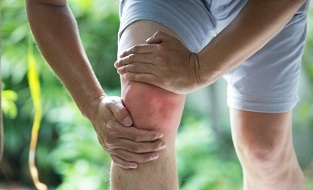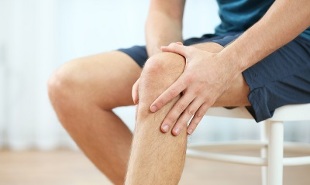
Knee arthrosis, or gonarthrosis, mainly affects women, usually after the age of forty. At an earlier age, such pathology may develop as a result of injury or occupational sports. A particularly severe course of the disease is observed in people who are overweight or suffer from varicose veins of the lower extremities.
The onset of the disease is characterized by the appearance of moderate pain in the knee during movement, especially when walking up stairs. Also, pain can occur if a person stands for a very long time or stands up after a long stay in a sitting position. At rest, the pain usually subsides. Acute and severe pain in osteoarthritis of the knee joints does not occur spontaneously, usually preceded by long-term discomfort when walking, physical activity. Significantly increasing pain is one of the main signs of gonarthrosis.
Stages of the disease
The first phase
In the initial stage of gonarthrosis development, the bones in the knee do not change their shape, only swelling of the ankle can occur, which is usually accompanied by accumulation of fluid in the knee. If its amount exceeds the allowed level, edema develops, affecting the back of the foot. In this case, you can ease the bloating with the help of anti-inflammatory medication.
The second phase
The next stage of knee osteoarthritis is characterized by a significant increase in pain intensity. The pain makes itself felt even after a light load, a crisis appears in the knee joint, which intensifies if the disease progresses. The patient bends the leg with difficulty, has severe pain, to the point of complete inability to bend the knee. Also in the second stage of the disease, the joint begins to change its shape, which becomes quite visible to the touch - the expansion and implantation of the articular bone is felt. Synovitis manifests itself much more strongly at this stage - the appearance of bloating as a result of fluid accumulation.
The third phase
The third stage of the disease is characterized by the appearance of severe pain that occurs even at rest. The patient is looking for a suitable position for a long time, in which the pain will be weaker. With impaired blood circulation, the pain can bother a person even during sleep, causing a painful sensation in the joints. The mobility of the ankle is minimized, the person is often unable to hold the foot in an upright position and is forced to bend it when walking. With significant bone deformation, the gait becomes shaky, a change in the shape of the lower extremities becomes noticeable.
How to recognize osteoarthritis of the knee joint?

The patient is initially referred for a blood test, followed by an x-ray, magnetic resonance, or computed tomography.
In some cases, ultrasound or arthroscopy (examination of the wrist with a special device through a small incision) may be prescribed.
During the X-ray examination, the stage of development of the disease is determined, the picture shows changes in the joints and bones, as well as the distance between the bones. At an early stage of the disease, changes in cartilage tissue are not noticeable on an x-ray.
Ultrasound examination, as well as computed tomography, allows the detection of abnormalities in the soft articular tissues and the determination of the amount of fluid accumulated during the development of synovitis.
How is knee osteoarthritis treated?
Knee osteoarthritis is treated by specialists such as a rheumatologist or orthopedist. At an early stage, the disease in most cases is curable without surgery, but treatment must necessarily be comprehensive and qualified. In the second and third stages, it is impossible to return the joint to its previous shape without surgery, it is only possible to improve the condition of the periarticular tissue.Non-steroidal anti-inflammatory drugs are widely used to reduce inflammation and pain in osteoarthritis of the knee joints. After reducing the pain syndrome, the patient may be prescribed massage, therapeutic exercises, physiotherapy procedures.
For the treatment of gonarthrosis, drugs are also used that are part of the group of chondroprotectors and provide the restoration of cartilage tissue. Such preparations also help maintain the elasticity of the cartilage, saturating its tissue with moisture. In the first and second stages, chondroprotectors have a gradual effect, the treatment is quite long and can last even a year or a year and a half. Taking glucosamine and chondroitin sulfate together has a greater effect. In the third stage, such drugs are no longer able to have a positive effect.
A good effect in the treatment of osteoarthritis has medicines that serve to dilate blood vessels. They are able to improve blood circulation to the joints and relieve spasm in small vessels, which helps restore the affected joint. It is recommended to combine taking such drugs with the use of chondroprotectors. In order to relieve painful muscle spasm, the patient may be prescribed muscle relaxants. Such drugs are used only in combination with chondroprotectants and joint resection. A Dimexide compress also has a positive effect in treating osteoarthritis, which reduces inflammation and relieves pain, especially when fluid accumulates. To prepare such a compress, you need to mix a tablespoon of boiled water with a tablespoon of Dimexide. Then soak a medical bandage in the resulting solution, then place the affected knot and cover with a plastic bag and a diaper on top. The duration of the procedure is from twenty to sixty minutes, once a day, no more, for two to three weeks.
All medicines are used in the absence of contraindications, exactly as prescribed by your doctor. Knee osteoarthritis requires medication and physiotherapy and therapeutic exercises.

























